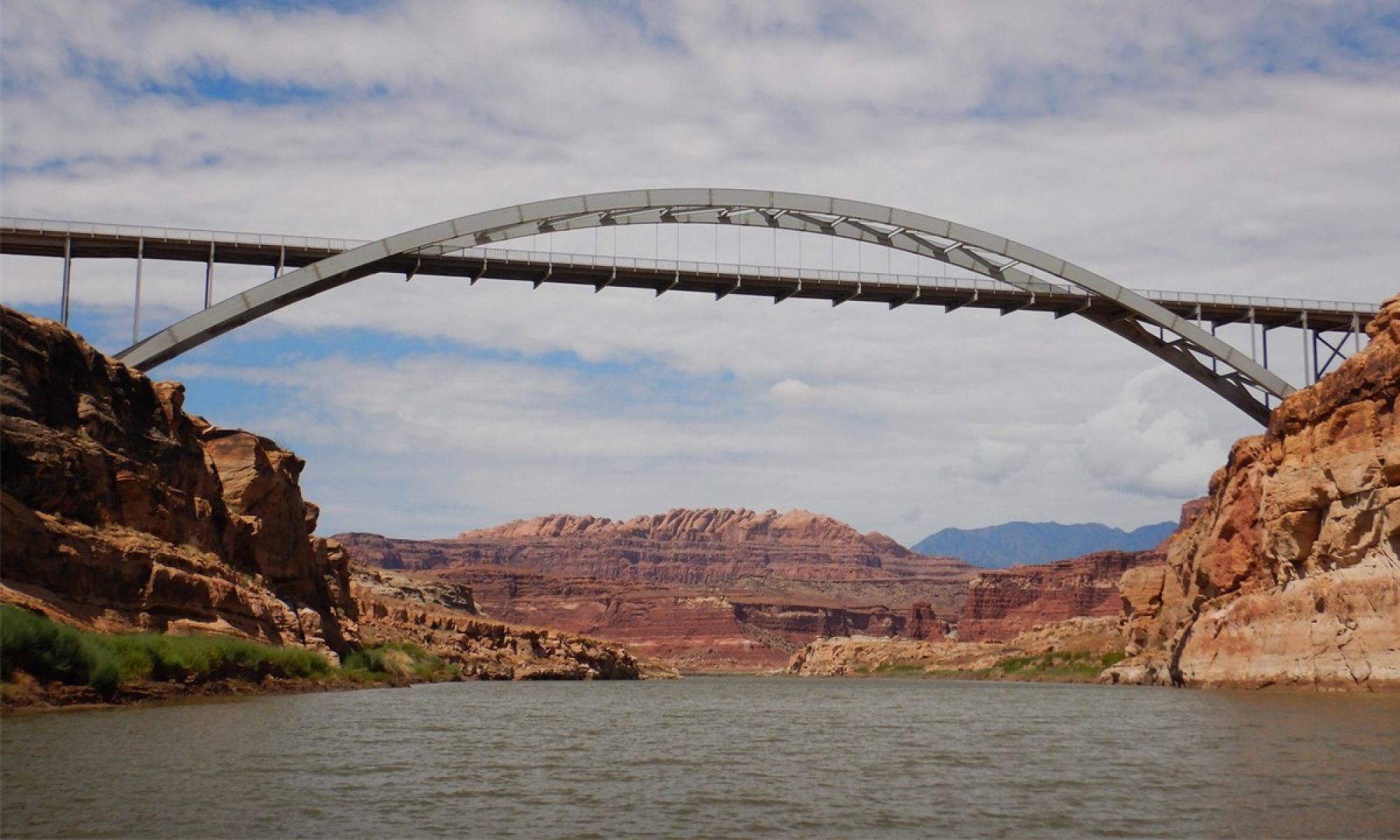Sailing the Red & Arabian Seas
South on the Red Sea
Our journey to Oman will begin by heading south in the Red Sea past Sudan, Saudi Arabia and Eritrea. The ship has opened the pool and the hot tubs, and the sauna and exercise machines are all now up and working. That afternoon we have our first at-sea talk by our Cruise Director, Amani, reviewing our upcoming itinerary, while appetizers and wine are served. Dinner was at 7pm and, because today is Thanksgiving, a turkey, chicken, and duck feast is served. That night, they show the movie “Death on the Nile” in the lounge along with free popcorn, and that evening, we check out the hot tubs on deck with a well-deserved nightcap.
The next morning, we rise early for a quick workout in the gym. Despite the rocking of the boat, the treadmills are all working fine. After a quick visit to the sauna and it’s showers, we head for coffee, and a light breakfast before a morning talk by our sociologist/historian, David, who talks about “How a Humble Canal Sunk an Empire!”.
The Suez Canal
The 19th century was the “age of the canal”, with the building of the Erie Canal, the Panama Canal, and the Suez Canal. The Suez Canal was originally conceived and began by the Frenchman, de Lesseps, and it was anticipated to be economically transformative, as it would save 5,000 miles of shipping travel between Asia and Europe. Early in its history, the British tried to sabotage its construction by the French, but the French persevered. The canal was built principally by slave labor and Egyptian peasants and it opened in 1869. At the time, it was seen as an equivalent of placing a man on the moon today. The opening was marked by a grand procession of boat parades through the canal. However, the canal did not bring riches to the area and, instead, the Egyptian economy failed, leading to unrest and protests. Eventually, in order to preserve its use, the canal area was declared a neutral zone by the British, which soon led to the British to build settlements in Africa and then in the Middle East. At one time, Winston Churchill even sent tanks to the area to protect the Canal. Eventually, Egypt’s leader, Nasser, nationalized the canal and declared it the property of Egypt. This led to the1956 crisis where the British and the French bomb the canal fighting for control it. Finally, the British backed-down and control of the canal went to the Egyptians. This was a massive geopolitical moment as the humiliation to the Western European powers likely encouraged the Soviet Union to invade Hungary that same year. Today, there are two 2 parallel canal sets of locks and the canal has ~$9Billion impact daily.
After the morning lecture, we had a light lunch before taking a tour of the ship’s bridge. The ship is driven by diesel generators powering electric motors. Steering is all controlled by hi- tech toggles and joysticks with no traditional wheel. The ship was received from China on Oct 21, 2022 and was brought straight to our group after a quick stop in the Philippines to board staff. The bridge keeps two people on watch at all times; and while we were there, it was Ronald, the safety officer, and Dan, the watch officer, who were on duty.
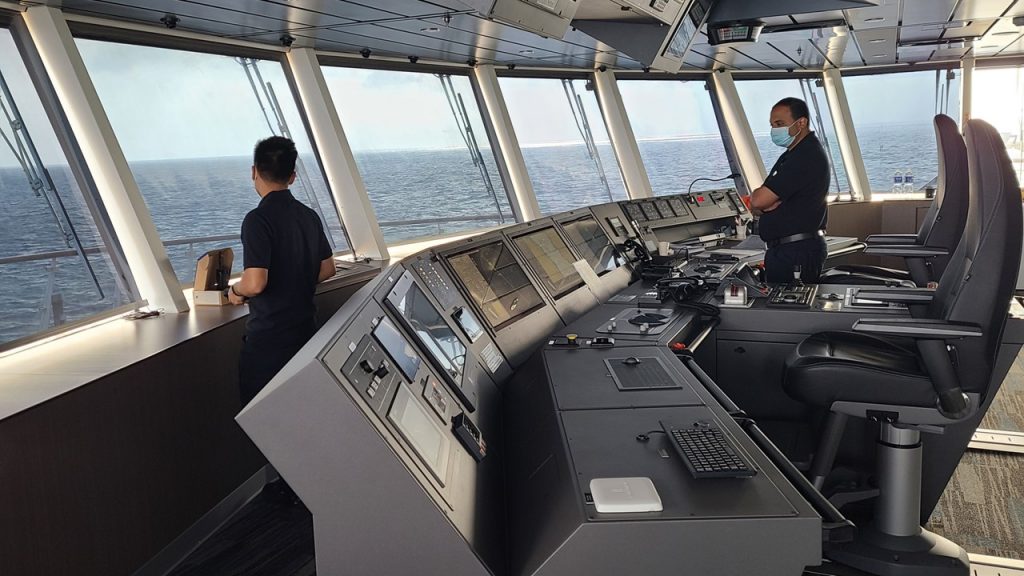
After the Bridge Tour, we took the occasion to go relax in the hot tub, as the pool was closed due to the dangerous “sloshing” of the water. At 4pm, we went to the ship’s Library for the daily high tea which included cakes, sandwiches, nibbles and bits, served with a variety of teas.
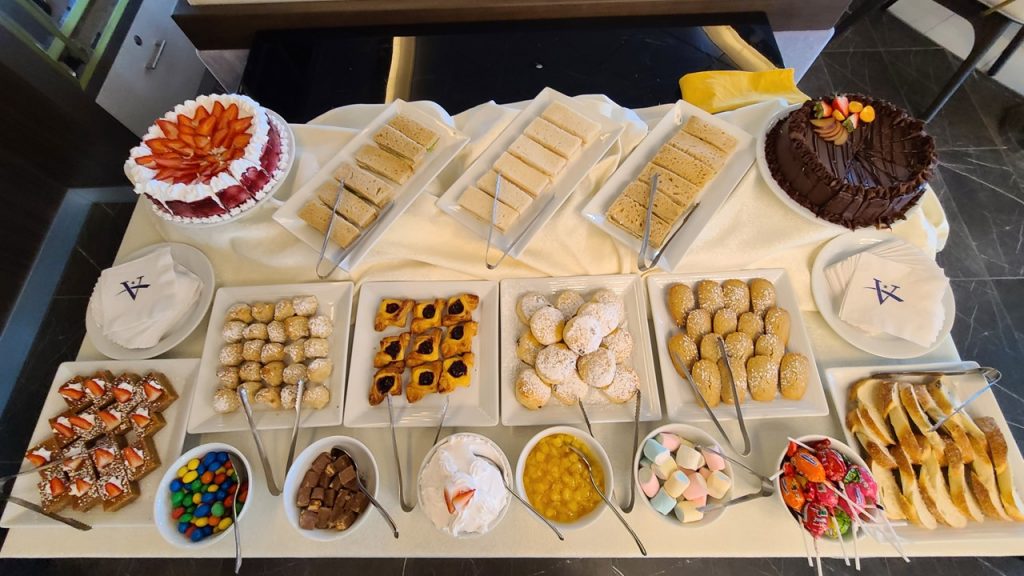
At 5:30pm, we headed to the Lounge for cocktail hour and our 6:30pm talk which reminded us of the need to change the time on our clocks tonight, We were also informed that 2+ guests had tested positive for Covid and would be quarantined in isolation in their cabin for the next 5-days. We were also told that before we exit the Red Sea, pass Djibouti, and enter the Gulf of Aden, we would come alongside of a floating “Security Station” where we would pick-up 4 Security Guards for the ship to travel the “pirate area in the seas between Somalia and Yemen. This has now become an insurance requirement for shipping in the region. These Security Guards will stay aboard until we leave the coast of Yemen and enter Omani waters and the Arabian Sea.
Saturday morning, we have breakfast and relax before meeting in the lounge for our morning lecture with David. Today’s topic is “Difficult Erections: The Curious Case of the Moving Obelisks.” Many of the world’s famous obelisks were “appropriated” from Egypt, and few people are fully aware of how their movement came to be.
Egyptian Obelisks
In Paris, at the Place de La Concorde where once a statue of their king stood, and which was replaced by a guillotine for public executions, stands an obelisk today. This particular obelisk is the right-hand-side one of the pair of Luxor Obelisks which were carved from a single piece of red granite in dedication to Ramses II to stand on either side of the portal of the Luxor Temple. It is 75 ft. high and was taken from Egypt in the 1830’s as a gift/reward to the French in recognition of Napoleon’s successful war with Egypt. It weighs 230 tons and took 7 years to move there. The “gift” originally included both obelisks, however, in 1981, President Mitterrand renounced possession of the second obelisk which remains at Luxor.
England had originally been promised the Luxor Obelisks but accepted the offer instead of one of Cleopatra’s Needles. These obelisks were made in Heliopolis (Cairo) during the 18th and 19th Dynasties, from the time of Ramses II and stood in Alexandria until one was toppled in ~1303AD. The toppled Needle was alternatively offered as a gift to the British in 1819 in commemoration of Lord Nelson in the Battle of the Nile. However, the British would not pay for its shipping until 1877, nearly 60 years later, when Sir William James Erasmus paid for its transportation to London from its space in the sand in Alexandria. It was erected on the Victoria Embankment which had just been built in 1870. Today, the obelisk is flanked by 2 fake sphinx which are facing the wrong direction. The site had been bombed during WW2, but the needle survived.
At the opening of the Suez Canal in 1869, Egypt’s ruler, Isma’il Pasha, gifted the USA the second of Cleopatra’s Needle obelisk from Alexandra in appreciation of the USA having remained neutral during the French-British conflicts there, and as their commemorative gift from the opening the Suez Canal. The Needle was moved to New York City by the US Navy and was erected in 1881 in Central Park just west of the Metropolitan Museum of Art.
All Egyptian obelisks are four-sided stone pillars with a pyramid-shaped top, carved from a single piece of stone, usually red granite. The obelisk symbolizes rebirth and was believed to attract the rays of the sun. They were commonly placed at sun temples in commemoration of the gods and to mark the entrance to the temple. There are 29 ancient Egyptian obelisks left in the world today. Nine are in Egypt, and eleven in Italy (eight of which are in Rome, having been pilfered by the Romans after Augustus defeated Antony and Cleopatra in 31 BCE, thereby conquering Egypt). Others are scattered around the world, often gifted to countries, including Lebanon, Turkey, and Poland. The largest obelisk outside of Egypt is in Rome at Piazza San Giovanni from the Temple of Karnak, and the Vatican Obelisk taken by the Romans from Heliopolis at St. Peter’s Square is the second largest.
After the lecture, we laid out on deck and enjoyed the sunny day. After lunch, the Security Force of 4-men came onboard. They brought with them many large cases of weapons and military gear, which they are not allowed to have in any Middle Eastern country, but which they can possess at their floating base in international waters located on the high sea.
That afternoon, we took a Cooking Class and learned from Chef Indra how to make “Mandy Chicken” – a light chicken curry, and from Chef Richard how to make “Tabouli“. Both dishes were quick and tasty! Then, it was “Hot tub time” again before showering and heading off to daily tea-time.
Before dinner, we all met with our new Security Force for a “Security Briefing”. The Security Team, part of “Ambrey Maritime Security” are all ex-military with multiple years of training and fighting experience. They reported that there had been no attacks on passengers ships this year, and that they stay on watch 24-hours a day with ship officers on the bridge. They will let us know if we need to raise the alarm. If an alarm is raised, there will be an announcement – “Pirate Attack, Pirate Attack, Pirate Attack.“ If such an alarm occurs, we were instructed to walk out of our cabins into the corridor, and to sit down with one’s back to the bulkhead, and not near the door, (for maximum protection from bullets). We are to move quickly and not pause to brush one’s hair or teeth. This Team usually works protecting commercial vessels and not passengers vessels, but the highest risk area has recently changed from the previous Egypt to India routes, to the Yemen to Oman routes, principally due to Somalia pirates.

Tonight, we are in the southern area of the Red Sea. In the Red Sea there are two routes for shipping referred to as the International Recommended Transit Corridors (IRTC). For security, the Japanese do flyovers all day long looking for small vessels that are out of ordinary. The last attack in this area was in December 2021 on a vessel with Rocket Propelled Grenades (RPGs). However, no attack has ever succeeded with Ambrey Security aboard. They will stay aboard for ~4-days until we are past Yemen and off the coast of Oman.
After dinner, we played a game of “Liar, Liar” with staff members Steve, Thyss, and David. It was Hilarious!! The night was concluded with dancing and great socializing.
The Story of Cleopatra
Sunday morning was quiet with a lecture after breakfast about “Making Egypt Great – Again”.” This was “Part 1” of the story of the real Cleopatra – Cleopatra VII, the last pharaoh of Egypt and a great historical and political figure of glamour and myth. Cleopatra was from Alexandria and was well educated and spoke 9 languages. She grew up in a time when Alexandria was home to many Greek elite, and it was common among her culture to marry siblings and children. At this time, the Roman Republic was the great power in the land and Egypt was a heavily taxed region. Cleopatra sought an alliance with Rome and an audience with Caesar, and when she was 21-years-old, she had herself wrapped in a rug and smuggled into his presence in Rome. At 57-years-old, Caesar was smitten by her boldness and beauty and began a romantic relationship with her that lasted many years. Meanwhile, Cleopatra returns to Egypt with promises and concessions, marries her 12-year-old brother and successfully rules Egypt with him. She maintains her relationship with Caesar for many years.
The story takes a break for lunch and an afternoon of swimming, hot tubs, and high tea. Dinner is followed by the movie “Top Gun Maverick” with drinks and popcorn.
The next morning after breakfast, everyone assembles for the rest of the story of Cleopatra – “Making Egypt Great – Again! – Part 2.” Her story resumes with Cleopatra killing her brother/mate and ruling Egypt as the sole pharaoh. During her reign, she builds up Alexandria and begins a new relationship and alliance with Marc Anthony by meeting with him in Taurus, and plotting against their other Roman foes, including Octavia. Marc Anthony returns to Egypt with Cleopatra where she gives birth to twins, Cleopatra Selene and Alexander Helios. She and Marc plot to take over the world, but their forces lose at the Battle of Actium, and Cleopatra returns to Egypt and barricades herself in her mausoleum. In defeat, Marc Anthony kills himself, and upon hearing the news, Cleopatra also kills herself. Octavia thus becomes the ruler of the Roman Empire including all of Egypt. Cleopatra’s children were taken to Rome where her son, the heir to the throne of Egypt, died and her lineage disappeared. Today, Cleopatra’s tomb may have been recently discovered outside of Alexandria.
Our morning story was followed by wine-tasting, and, by lunch time, we had each had 6 glasses of wine! After lunch, it was back to the hot tubs for conversations with fellow travelers before showers, high tea, and a competition with a battery of “tricky questions.” The winning team was rewarded with sparkling wine. This was followed by what was supposed to be a “port talk”, but we were informed instead that the ship was not traveling as fast as been predicted, and that we would not reach our planned Port of Salalah in Oman tomorrow, as the itinerary had indicated. Designated transit corridors, winds, and current were all put to blame, plus, we still needed to drop off our Security Force. A change in plans were proposed and effort began to arrange an additional port stop in the Omani city of Muscat, after our stop in Sur.
At dinner, the conversation focused on the uncertainty of where would next make land and what changes to plans would have to be made. This was especially true for some of the ship’s staff who had made arrangements for embarking and/or disembarking in Salalah.
The British East India Company
Tuesday morning we were still at sea and, after a stint in the gym, we went to breakfast late. Today’s morning lecture was by David Kampfer Part 1 about “Pirates or Gentleman – the strange tale of the British East India Company” The British had been in India for over 92 years. In fact, the Powis Castle in Wales has one of the largest collection of Indian artifacts and relics – larger than in the Delhi Museum in India.
The British East India Company had begun with a small office and 35 employees in the 1590’s as a company given permission by the British Government to loot and pirate passing ships of foreign countries. Up until then, the Spanish and Portuguese had a monopoly on the spice trade to Europe. The East Indies, (Indonesia today), was the source of spices and riches to Europe, and the BEIC could plunder competitors at will, to the British Crown’s benefit. The company met with opposition from the Dutch in the Dutch East Indies (now Indonesia) and the Portuguese. The Dutch virtually excluded company members from the East Indies after the Amboyna Massacre in 1623 (an incident in which English, Japanese, and Portuguese traders were executed by Dutch authorities), but the BEIT Company’s defeat of the Portuguese in India (1612) by Lord Clive won them trading concessions from the Mughal Emperor Shah Alam. The company settled down to a trade in cotton and silk piece goods, indigo, and saltpeter, with spices from South India. It extended its activities to the Persian Gulf, Southeast Asia, and East Asia. Soon, the British East India Company (BEIC) was given permission to take tax control of the 3 richest regions of India, and subsequently, the British took control of the highly profitable cotton mills and began to move them to Manchester – soon known as “Cottonopolis“. Manchester remained the textile capitol of the world until America took over that role many years later.
Lunch was followed by the showing of the original movie of “Cleopatra”, daily tea time, and an update concerning our extended time at sea. We would not only miss stopping at Salalah, but we might miss our stop at Sur, as well. The growing disappointment and frustration was softened by an accompanying open bar declaration with free drinks and appetizers. This was followed by a surprising change that came as a result of our suggestion a few days earlier – the crew has arranged an open-deck evening BBQ for us for dinner! Deck 8 at sunset was the site of the food – a suckling pig, burgers, and ribs, with all of the associated salads and side-dishes, and a pastry assortment of pies and cakes. Because of the darkness, the crew and chefs used their phone flashlights to highlight the food and help the guests to their deck-side tables. This was all accompanied by a DJ and followed by on-deck dancing. A truly great evening!
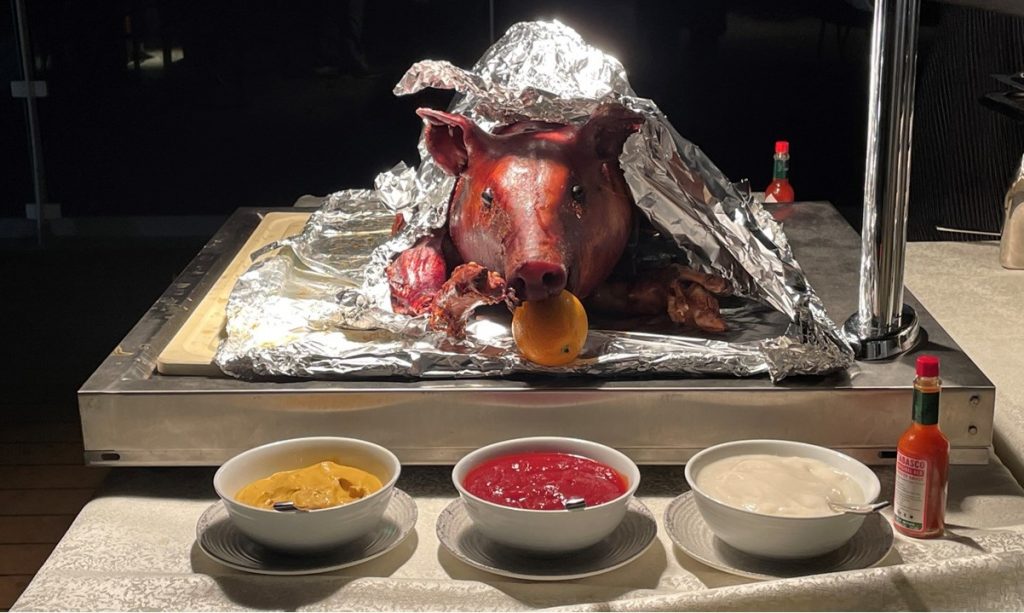
Than evening, after dark, we pulled-up near the floating Ambrey ship-base where we were met by a large zodiac that the Ambrey Security Forces exited our ship onto. From here, they plan to board a cargo ship heading in the opposite direction.
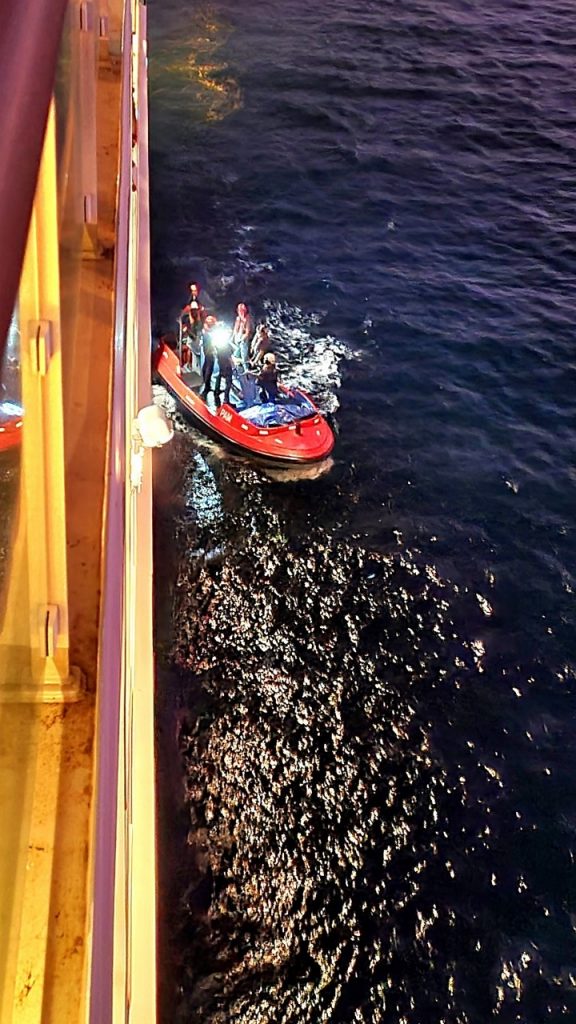
That night, my cell phone livestream coverage provided a play-by-play for the World Cup match of USA vs Iran, a 1-0 USA win. Our ship still does not have satellite access, and the World Cup is only shown on pay-per-view in this part of the world anyways, so we considered ourselves lucky to have gotten even this coverage.
The next morning, still at-sea, breakfast is followed by part 2 of our lecture on “Pirates or Gentleman – the strange tale of the British East India Company.” With the endorsement of the British government, the BEIT began using slave labor and transporting enslaved people to its facilities in Southeast Asia and India. Although some of those enslaved by the company came from Indonesia and West Africa, the majority came from East Africa—from Mozambique or especially from Madagascar—and were primarily transported to the company’s holdings in India and Indonesia. Large-scale transportation of slaves by the company was prevalent from the 1730s to the early 1750s and ended in the 1770s. Beginning in the early 19th century, the company financed the tea trade with illegal opium exports to China. Chinese opposition to that trade precipitated the first Opium War (1839–42), which resulted in a Chinese defeat and the expansion of British trading privileges. The company gradually lost both commercial and political control, and its commercial monopoly was broken in 1813. After 1834 it was merely a managing agency for the British government of India, and it was removed from that role after the Indian Mutiny (1857), and it ceased to exist as a legal entity in 1873. During its run, other trading companies for investors were set up, including the Royal Africa Trading Company, the Hudson Bay Trading Company, and the Muscovy Russia Trading Company.
After our lecture, the ship’s chefs gave another cooking lesson in the lounge making Caesar Salad with homemade dressing and Shrimp Fried rice. After lunch, deck time and tea time, we finally had a Port talk indicating that we would definitely not be able to go to Sur, Oman due to lack of tenders to ferry us to shore. However, the crew had successfully arranged for us to go to port in Muscat tomorrow, instead. Muscat is known for its good beaches, with no high-rises; and good schools – often referred to as “the Switzerland of the Middle East”. Sultan Haitham bin Tariq rules the country, which was founded 900 years ago, and is an oasis of greenery, cleanliness, and order. It is characterized by a modern road network and advanced organized services, with a very high standard of living. We are told about the excellent shopping there and the basics of “haggling”. Frankincense is a popular item for tourists and should cost in the $5-10 range for a packet. At dinner, everyone is excited to have a chance to exit the ship tomorrow, and the evening is uneventful.
